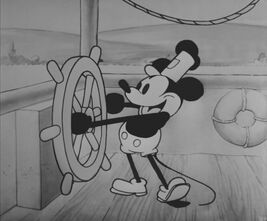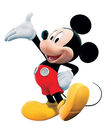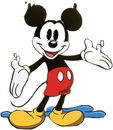(Adding categories) |
|||
| Line 227: | Line 227: | ||
[[Category:Keyblade Masters]] |
[[Category:Keyblade Masters]] |
||
[[Category:Keyblade Wielders]] |
[[Category:Keyblade Wielders]] |
||
| + | [[Category:Comedy Characters]] |
||
| + | [[Category:Masters Of Good]] |
||
| + | [[Category:Rodents]] |
||
| + | [[Category:Slender characters]] |
||
| + | [[Category:Characters who go barefoot]] |
||
| + | [[Category:Characters in sandals]] |
||
| + | [[Category:Servants]] |
||
Revision as of 22:26, 6 February 2011
- “I love Mickey Mouse more than any woman I've ever known.”
- ―Walt Disney[src]
Mickey Mouse is an animated anthropomorphic mouse created by Walt Disney and Ub Iwerks in 1928. Arguably by far its most popular character, Mickey serves as the mascot for The Walt Disney Company.
Fancifully estimated as standing 2 ft 3 in (69 cm) and weighing 23 pounds (10 kg), Mickey rapidly rose to the pinnacle of American culture, being more widely recognized overseas than any other American icon but the U.S. flag. For over eighty years, he has signified The Walt Disney Company, animation, goodwill, fun, laughter and most of all Walt Disney himself. It was said by Lillian Disney, his wife, that over the years, Mickey and Walt grew together and were mirrors of each other's personality. They both started off mischievous and cheeky, but as they grew older preferred to step out of the spotlight and observe others work their magic. President Jimmy Carter once said; "Mickey Mouse is the symbol of goodwill, surpassing all languages and cultures. When one sees Mickey Mouse, they see happiness".
Mickey's 3-circle silhouette serves as the logo for most of Disney's subsidiaries, save for the ones that don't carry the 'Disney' or 'Walt Disney' label. Andy Warhol's portrait The Art of Mickey Mouse used Warhol's famous pop art techniques on the classic mouse. Mickey is often cited as the world's most beloved cartoon character.
Personality
Mickey's personality has had one of the biggest changes in Disney history. In his first cartoon, Plane Crazy, Mickey was mischievous, rude and foolish. Walt's character was unpopular to this and was changed to a more heroic character. As a result, Mickey became heroic and comical. Mickey will save almost anyone in danger, especially Minnie Mouse, his leading lady. Mickey and Minnie's relationship has had many troubles in it throughout the years, but the duo always seem to work things out. Although his personality changed, Mickey still kept his aggresive personality shown mostly in the presence of his rival, Mortimer Mouse. Mortimer was Minnie's love before Mickey and will do anything to get her back. Mickey and Mortimer both hate each other and usually battle for Minnie's affections. Mickey's popularity led to a rivalry with Donald Duck. Mickey has no clue about the rilvary and always counts Donald as one of his best friends. Mickey sees Goofy as a close friend and personal sidekick. Mickey and Goofy both have forgetful personalities which usually land the two in much trouble. Mickey's absoulute best friend is his dog Pluto. Overall Mickey is an imaginative, fun, comical mouse always looking for a new magical adventure.
Creation and Debut

Mickey in one of his first appearances, in Steamboat Willie.
Mickey was originally created as a replacement for Oswald the Lucky Rabbit, an earlier star created by the Disney studio. Oswald had been created by Walt Disney and Ub Iwerks for Charles Mintz of Universal Studios. In fact, Mickey closely resembled Oswald in his early appearances. However, Disney received an unpleasant lesson when he asked Mintz for a larger budget for his popular Oswald series: in reply, Mintz fired Disney and Iwerks and taken all of Disney's artists to draw Oswald, to which Mintz and Universal owned the rights. From that point on, Disney made sure that he owned all rights to the characters produced by his company. Oswald would eventually return to the Disney fold in 2006 as part of a trade between NBC Universal and Disney, with NBC getting the contract of sports announcer Al Michaels as compensation.
In order for Walt and his older brother and business partner Roy to keep their company active, new characters had to be created to star in their subsequent animated shorts. One day, during a train ride, Walt desperately wanted to come up with a money-making character to replace the one he lost, Oswald, whom he loved dearly. He had visions of a mouse in the back of his head (he had previously made silent cartoon shorts with animated mice). He wanted to name his new creation Mortimer Mouse, but his wife Lillian Marie Bounds thought the name was too pretentious, so she suggested he change it to Mickey Mouse which he did. The name Mortimer would later be used for a character in a Mickey cartoon, that oddly enogh, became a new rival for Mickey.
It has been suggested that Walt Disney was influenced by an actual mouse that he almost tamed by feeding it crumbs on his desk at the Laugh-O-Gram Studio.
Mickey and Minnie Mouse (Mickey's flapper girlfriend) debuted in the cartoon short Plane Crazy, first released on May 15, 1928. The short was co-directed by Walt Disney and Iwerks. Iwerks was also the main animator for this short, and reportedly spent six weeks working on it. Hugh Harman and Rudolf Ising were credited for assisting him; these two had already signed their contracts with Charles Mintz, but he was still in the process of forming his new studio and so for the time being they were still employed by Disney. This short would be the last they animated under this somewhat awkward situation.
The plot of Plane Crazy was fairly simple. Mickey is apparently trying to become an aviator in emulation of Charles Lindbergh. After building his own aircraft, he proceeds to ask Minnie to join him for its first flight, during which he repeatedly and unsuccessfully attempts to kiss her, eventually resorting to force. Minnie then parachutes out of the plane. While distracted by her, Mickey loses control of the plane. This becomes the beginning of an out-of-control flight that results in a series of humorous situations and eventually in the crash-landing of the aircraft. A non-anthropomorphic cow that briefly becomes a passenger in the aircraft is believed to be Caroline Cow making her debut.
Plane Crazy apparently failed to impress audiences, and to add insult to injury, Walt could not find a distributor. Though understandably disappointed, Walt went on to produce a second Mickey short: The Gallopin' Gaucho. It would not be until Mickey's third, probaly most famous, and first sound cartoon Steamboat Willie, that Mickey began to gain the popularity that he has today. In fact, Steamboat Willie was so popular that Walt made it's release date, November 18, 1928, Mickey's birthday.
Mouse in Transition
Mickey Mouse entering Depression Era
The twelfth and last Mickey short released during the year was Jungle Rhythm, first released on November 15, 1929. Mickey is seen in a safari somewhere in Africa. He rides on an elephant and is armed with a shotgun. But the later proves to be problematic soon after Mickey finds himself standing in between of a lion and a bear. Mickey proceeds to play music to calm them down. During the rest of the short, various jungle animals dance to Mickey's tunes. The tunes vary from the previously mentioned "Yankee Doodle" and "Turkey in the Straw" to Robert Burns' "Auld Lang Syne" (1788), Johann Strauss' "The Blue Danube" (An der schönen, blauen Donau - 1867) and Queen Liliuokalani of Hawaii's Aloha `Oe - 1878. This was the first Mickey short to be released during the Great Depression. Mickey's efforts as an entertainer to the jungle can be seen as representative of a function often credited to him. To provide relatively cheap but much needed entertainment to the audiences of the period of Jimmy Durante.
Later Mickey Mouse History
Mickey in his first color cartoon The Band Concert
1930-1950
In his earliest cartoons Mickey was often mischievous and the cartoons sometimes used outhouse humor. As the series became more popular, Disney decided to change his best-known character into a well meaning everyman, and creating mischief was thereafter left to other characters.
From 1930 until 1950, though the numbers of the comic creators that worked on Mickey increased, the most popular version (considered the "classic" version today) was that of Floyd Gottfredson, who developed Mickey's character, adopted characters from the cartoons, and created many others. Since 1950 the most popular version of Mickey has been that of Italian creator Romano Scarpa, who has further developed Gottfredson's characters and has added many of his own.
Mickey's most well known supporting characters are his girlfriend, Minnie Mouse; his dog, Pluto; and his best friends, Goofy and Donald Duck and his girlfriend Daisy Duck.
By his older sister Amelia Fieldmouse Mickey has two nephews, Morty and Ferdie Fieldmouse.
In 1929, Disney created the original Mickey Mouse Club for fans of his character and cartoons, which later formed the basis for a popular 1950's television show (with follow-ups of the same name in the 1977 and 1989).
Mickey has starred in the theatrical feature film: the "Mickey and the Beanstalk" segment of Fun and Fancy Free (1947). He has also starred in two half-hour theatrical featurettes, Mickey's Christmas Carol (1983, screened in front of a re-issue of The Rescuers) (1990, screened in front of The Rescuers Down Under).
Many television programs have centered around Mickey, such as the recent shows Mickey Mouse Works and House of Mouse.
For many years, Mickey Mouse has served as the mascot for The Walt Disney Company, alongside Jiminy Cricket and Tinkerbell.
Fantasia

Mickey in his first film Fantasia
Mickey's most famous role is in the 1940 film Fantasia. In the film Mickey appears in a segment called The Sorcerer's Apprentice.
Mickey's Once Upon a Christmas
Mickey appears in both of the film Mickey's Once Upon a Christmas and Mickey's Twice Upon a Christmas. In the first film Mickey needs a present for Minnie and does a great job at work to get some. Mickey's plan succeds but when he stops Pete from selling a over priced tree to a poor family his money is taken away and he is fired. Mickey then sells his harmonica in order to buy the gift, a chain for Minnie's watch. When it's time to open presents Minnie's gift was a case for Mickey's harmonica witch she used her watch to buy. The two realize their most prized posessions are each other and Christmas is saved. Mickey reappears in the sequel. In the film Mickey and Pluto have an argument and Pluto runs away. Mickey spends the enitre day trying to find him with little luck and in the end Mickey reunites with Pluto with the help of Santa Claus.
Mickey, Donald and Goofy: The Three Musketeers
Mickey is one the main protagonist in the animated film based off the book by the same name. Mickey is a janitor and dreams of being a musketeer. When Pete, the captain of the musketeers grant Mickey, Donald and Goofy thier wish as apart of his evil plans, Mickey falls in love with the princess Minnie Mouse. All in one day Mickey, Donald and Goofy prove that they are great musketeers and Pete kidnaps each one by one. While Clarabelle Cow takes care of Goofy, Donald is left with the Beagle Boys and Mickey is left with Pete. Pete takes Mickey to his dark castle and imprisons him inside a dungeon. Mickey is soon freed by Donald, Goofy and Pluto and they set off to rescue Minnie. Mickey, Donald and Goofy battle the Beagle Boys. The battle soon leads a one on one between Mickey and Pete. The two sword fight until Pete punches Mickey across the Opra Stage. Donald and Goofy reappear and assists Mickey in fighting Pete. Pete is defeated and Mickey marries Minnie as well as become a Royal Musketeer.
Recent popularity
On November 18, 1978, in honor of his 50th anniversary, he became the first cartoon character to have a star on the Hollywood Walk of Fame. The star is located on 6925 Hollywood Blvd.
Throughout the decades, Mickey Mouse competed with Warner Bros.' Bugs Bunny for animated popularity. But in 1988, in a historic moment in motion picture history, the two rivals finally shared screen time in the Robert Zemeckis film Who Framed Roger Rabbit.
Only three people have regularly provided the voice for Mickey (not including theme park attractions and parades), Walt Disney from 1928 to 1947, James MacDonald from 1948 to 1983, and Wayne Allwine, from 1977 until his death in 2009, who first voiced the Mouse in Mickey's Christmas Carol in 1983. Hallmark greeting card illustrator Bret Iwan was chosen to represent the new voice of Mickey, starting with a Mickey toy. He has also done Mickey for Disney Cruise Line promotions, and he is featured in the Disney On Ice: Celebrations ice show. Mickey's most recent theatrical cartoon was 1995's short Runaway Brain, while in 2004 he appeared in the made-for-video features The Three Musketeers and the computer-animated Mickey's Twice Upon a Christmas. As of 2010, Mickey is the star of Disney Channel's Playhouse Disney series Disney's Mickey Mouse Clubhouse.
Mickey served as the Grand Marshal of the Tournament of Roses Parade on New Year's Day 2005, as part of the kickoff of the "Happiest Homecoming on Earth", celebrating Disneyland's 50th Anniversary. In 2009 Mickey has reappeared in balloon form in the famous Macy's Thanksgiving Day Parade, dressed as the captain of the Disney Cruise Line.
In 2010, three dozen Mickey statues were used to promote the Major League Baseball All-Star Game, which was played in Anaheim, California, adorned with insignias of the teams.
In video games
- Main article: Mickey Mouse in video games
Disney Parks
Mickey Mouse as he usually appears at the Disney Parks.
Ever since Disneyland first opened in 1955, Mickey and the gang have been an important part of the Disney theme park experience. Today, they can be seen everyday in shows, parades, and meet-and-greet opportunities at all 11 Disney theme parks worldwide. He is the most requested character in the parks. Classic cartoons staring the beloved characters are also screened in the Main Street Cinema at Disneyland and the Town Square Exposition Hall at Walt Disney World's Magic Kingdom. Back in Disneyland's old Adventure Thru Inner Space, most of the molecules were shaped around Mickey heads.
Fantasmic!
Mickey appears in the nighttime spectacular Fantasmic! In the show Mickey is the hero and must save the world of Disney from a group of Disney Villains led by The Queen. Mickey first appears at the very beginning as he is conducting water and expressing his powerful magic. Mickey is then taken into the cave of Wonders by Jafar, who turns into a snake in order to kill Mickey. Mickey then rubs the lamp (believing Genie will come and help) and it turns Jafar into a powerful Genie. Next Mickey must battle Maleficent as a dragon. Mickey uses the sword in the stone to defeat Maleficent and the villains. Mickey then transforms into a sorcerer and express fireworks and water. Mickey then says Some imagination huh?, and with Mickey's famous laugh he disappears and the show ends.
Mickey's PhilharMagic
In Mickey's Philharmagic Mickey conducts an orchestra with the help of his sorcerer hat. Donald Duck accidntally loses the hat and goes through some of Disney's most famous films. Mickey retrieves the hat and puts an end to the trouble Donald started.
Dream Along with Mickey
Mickey appears as the main character in Dream Along with Mickey. Mickey and Friends celebrate the world of dreams and try to help Donald realize people do believe in dreams. In the end Donald helps Mickey defeat Maleficent along with her henchmen Captain Hook and Mr. Smee.
Catchphrases
Mickey like Donald and Goofy has many catchphrases. Some of Mickey's most famous catchphrases are Hey Everybody, See ya Real Soon and Hot Dog. Some of his other well known catchphrases are Golly and Oh my gosh!.
Filmography
- Main article: Mickey Mouse's Filmography
Gallery
Animation
Disney Parks and More
Trivia
- Mickey has the tendency to use what's not his due to his incredible curiosity and imagination.
- Wayne Allwine's final performance of Mickey Mouse before his death was in Kingdom Hearts 358/2 Days. Because of this, there is a dedication to him in the credits of the English version of the game.
- Steamboat Willie's Mickey makes a cameo appearance as a transformation of Genie's in Aladdin and the King of Thieves.
- Although Mickey is usually shown to have magic powers with the Sorcerer Hat of Yen Sid, it is shown that Mickey can control magic without aid.
- Mickey's first-ever spoken line was "Hot Dogs!" in The Karnival Kid (1929).
External links
- Disney's Mickey Mouse character page
- Disney's Mickey Mouse character page (Japanese)
- Disney's Mickey and Friends character page (Japanese)
- Disney's HooZoo - Mickey Mouse
Template:Mickey and Friends
























